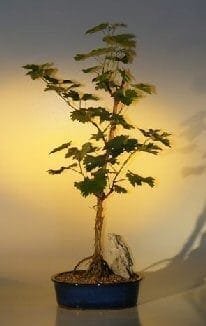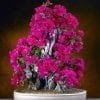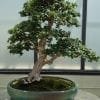Grapevine bonsai plants grow quickly and they require a lot of maintenance and care to grow successfully. Grapes are climbing vines in their natural environment.
However, grapevine bonsai plants grow to become bushy trees, and their size is only limited by how the gardener wants them to look. Growing a grapevine bonsai correctly can ensure that these plants thrive.
| Scientific/Botanical Name | Vitis vinifera |
| Description | Grapevines are natural climbers, growing at an extremely fast rate. The grapevine bonsai, however, grows into a shrubby tree rather than a vine. |
| Position | The grapevine bonsai needs between eight and 10 hours of indirect sunlight each day, and good air circulation. The plant must be protected from extreme cold. When grown indoors, the plant should be kept a few feet from the window to prevent leaf burn. |
| Watering | Grapevines need daily watering, and dry soil must be avoided. |
| Feeding | Beginning in spring, the plant should be fed every two weeks. It is important that the fertilizer used should not contain any type of herbicide. Grapevine dormancy begins in early-winter, and feeding must be stopped at that time. |
| Leaf and Branch Pruning | Given its rampant growth, shaping and pruning should be carried out regularly throughout the entire growing phase. When pruning, use clean, sharp shears. |
| Re-potting & Growing Medium | Re-pot the plant every two or three years. A soil mix of organic matter and sharp sand will ensure proper drainage. |
| Wiring | Wires can be used to shape plant to desired style. The wires can remain on the plant for a maximum of six months. |
| Notes | Proper care must be exercised when watering because fungal growth and bacterial diseases may afflict the plant Keep soil moist — but never soggy. |
Picking The Container
People who want to grow a grapevine bonsai should begin by selecting an appropriate container. A correctly sized container should be the same size as the diameter of the plant’s trunk.
Gardeners should ensure that the container they choose has holes to let water drain. They should also make sure that the container is stable when placed on a flat surface.
The bottom third of the container needs to be filled with a water retention layer. This should contain equal amounts of fine sand and potting soil.
Gardeners can remove the grapevine bonsai from the container that it came in after they have put in the water retention layer. It is best to remove excess soil gently so that the root system will not be damaged.
Gardeners should inspect the roots. They can use pruning shears to cut away any damaged areas.
However, removing too much of the root system can cause dieback. Bonsai enthusiasts should make sure that they never remove more than a third of the roots.
The grapevine bonsai should be placed in the middle of the container. Gardeners can then fill the rest of the container with the soil mixture they have prepared.
It is important to make sure that all of the roots are covered with soil. The soil should be gently pressed in around the bonsai to make sure that it stays in an upright position.
Watering
It is important to water the grapevine bonsai plant immediately after it is potted. Gardeners should pour tepid water into the container until it flows out of the drainage holes evenly. They should ensure that all of the soil is saturated. The plant should be allowed to rest after it has been thoroughly watered. It should also be repotted every two to three years.
The plants should be watered every day or two to make sure that the soil is moist. Grapevine bonsai plants should never be allowed to dry out completely. However, it is also important that Gardeners do not give the plants too much water. Proper watering will ensure that the plant is not affected by bacterial diseases and fungi.
Location
The plants will grow best in warm areas that have proper ventilation. In the wild, grape plants grow in places with mild winters and long growing seasons. Grapevine bonsai plants will go dormant in cold temperatures. However, this is a natural occurrence, and it helps the plant grow. These plants should be kept in cool areas during the winter, but they should never be exposed to extreme cold.
Lighting
Grapevine bonsai plants should be placed in direct sunlight for eight to 10 hours per day. They should not be exposed to harsh afternoon light. Grapevine bonsai leaves can burn if the plants are kept too close to a window. It is best that they are kept at least two feet away from any source of direct sunlight.
Feeding/Fertilizer
It is important to choose the right fertilizer for grapevine bonsai plants. They should not contain herbicides as this can harm the fruit that the plant produces. Grapevine bonsai plants should receive fertilizer every other week beginning in the spring.
They should be fertilized throughout the growing season that ends in the early winter. Grapevine bonsai plants should not be fertilized during the dormant period.
Pruning/Shaping
Plants should be pruned and shaped with shears all through the growing season. The shears used should always be sharp and clean. These plants grow quickly, and it is best to prune them on a regular basis.
Gardeners should ensure that three to five canes are maintained on each branch. They should also water sprouts and trim shoots. Bonsai gardeners can use wire to give the plant the shape that they want. Wire can be left on for six months.
Grapevine bonsai plants should be hand-pruned in late winter. Gardeners should use pruning shears to make clean cuts when they are removing dead and wilted areas.
Fruit producing canes should be trimmed back biannually so that new ones can grow. Gardeners should always leave several buds intact so that grapes will grow the following year.
Harvesting
Grapevine bonsai plants should be harvested after the grapes have ripened. Gardeners can sample the grapes before they remove the entire cluster. The taste and color of the grapes won’t improve after they have been picked.
Because of this, gardeners should wait until the grapes are sweet if they plan on eating them. Each grape cluster should be harvested as it ripens.


